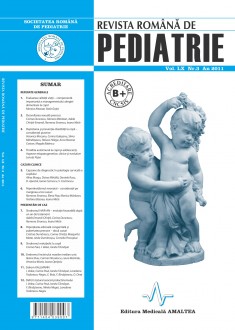SELECT ISSUE

Indexed

| |

|
|
|
| |
|
|
|

|
|
|
|
|
|
|
HIGHLIGHTS
National Awards “Science and Research”
NEW! RJP has announced the annually National Award for "Science and Research" for the best scientific articles published throughout the year in the official journal.
Read the Recommendations for the Conduct, Reporting, Editing, and Publication of Scholarly work in Medical Journals.
The published medical research literature is a global public good. Medical journal editors have a social responsibility to promote global health by publishing, whenever possible, research that furthers health worldwide.
Early sexual development
Corina Duncescu, Monica Marazan, Adela Chirita-Emandi, Ramona Stroescu and Ioana Micle
ABSTRACT
Puberty is a biological process that involves major physical and psychological changes at the end of which the child becomes an adult. Clinically, the onset of puberty is announced by the appearance of secondary sexual character that develops specific females, respectively to form the adult male, going through the five stages described by Tanner. The onset of puberty varies by race, ethnicity, geographic location, environmental and nutritional conditions, in the Caucasian population ranging from 8 to 12 years. Early sexual development is arbitrarily defined as the occurrence of secondary sexual characteristics before age 8 in girls and before age 9 in boys, respectively. Precocious puberty is classified into three broad categories: (1) gonadotropin dependent precocious puberty (central), (2) gonadotropin independent precocious puberty (peripheral), (3) partial precocious puberty. This paper aims to present the particular appearance of secondary sexual characteristics, the hormonal changes and the therapeutic possibilities of each category. Close follow-up of children, detailed medical history, chronological record of pubertal signs, repeated anthropometric and hormonal measurement are the key to a correct diagnosis and an early and effective treatment.
Key words: precocious puberty, gonadotropin, thelarche, adrenarche
